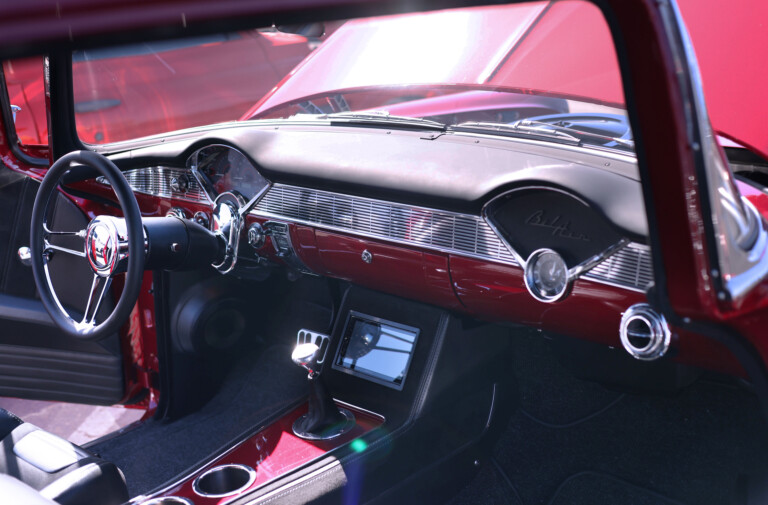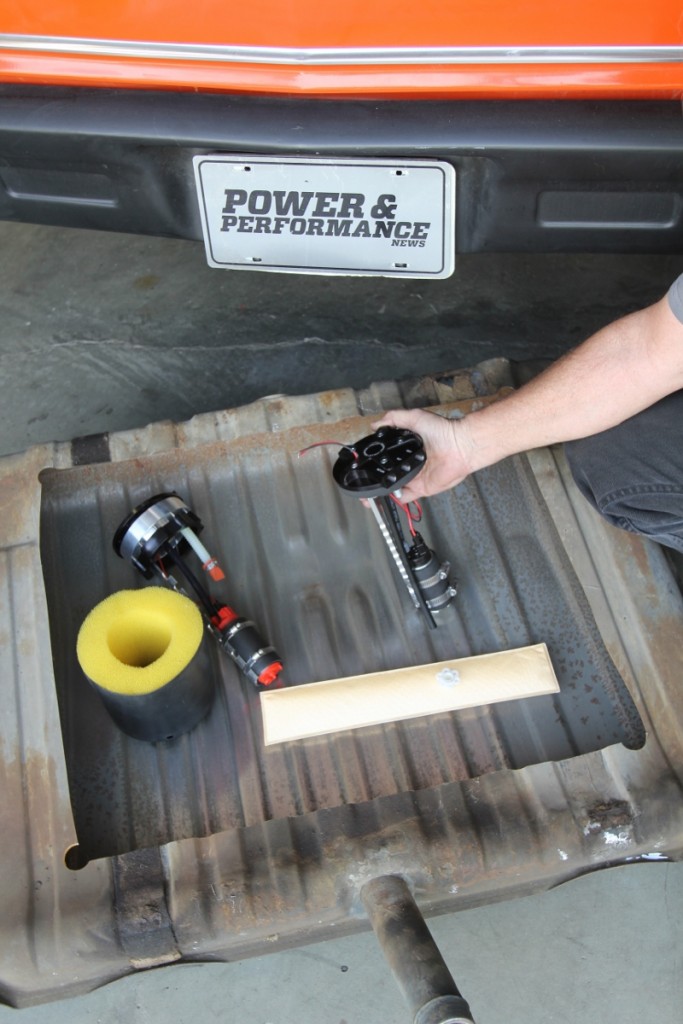
If there is EFI in your future, do yourself a huge favor and make the effort to build a proper fuel delivery system. One of the best ways to do this is by creating an in-tank fuel pump system. You can buy a ready-made tank or convert your own with any number of in-tank pump kits like these.
Words By Jeff Smith/Photos by Manufacturers and Jeff Smith
EFI has finally found a place among hot rodders. It’s taken more than 30 years, but car guys are beginning to accept that aftermarket EFI can work. Carve these following words in stone, though — “EFI is only as good as its fuel delivery system.” It’s as simple as that. The OE’s have certainly learned this caveat; every new car built in the last 20 years uses an in-tank electric fuel pump.
The streetwise car guys call this hanging pump system a pump on a stick. Not to be confused with ventriloquist Jeff Dunham’s laid-back “Jose Jalapeno on a Stick” character, these fuel pumps can quickly convert a muscle car’s non-reservoir fuel tank into a fully-functioning EFI-compatible fuel delivery system. But, before we get into the details of each system, it’s worth going into why we should go to all this effort in the first place.
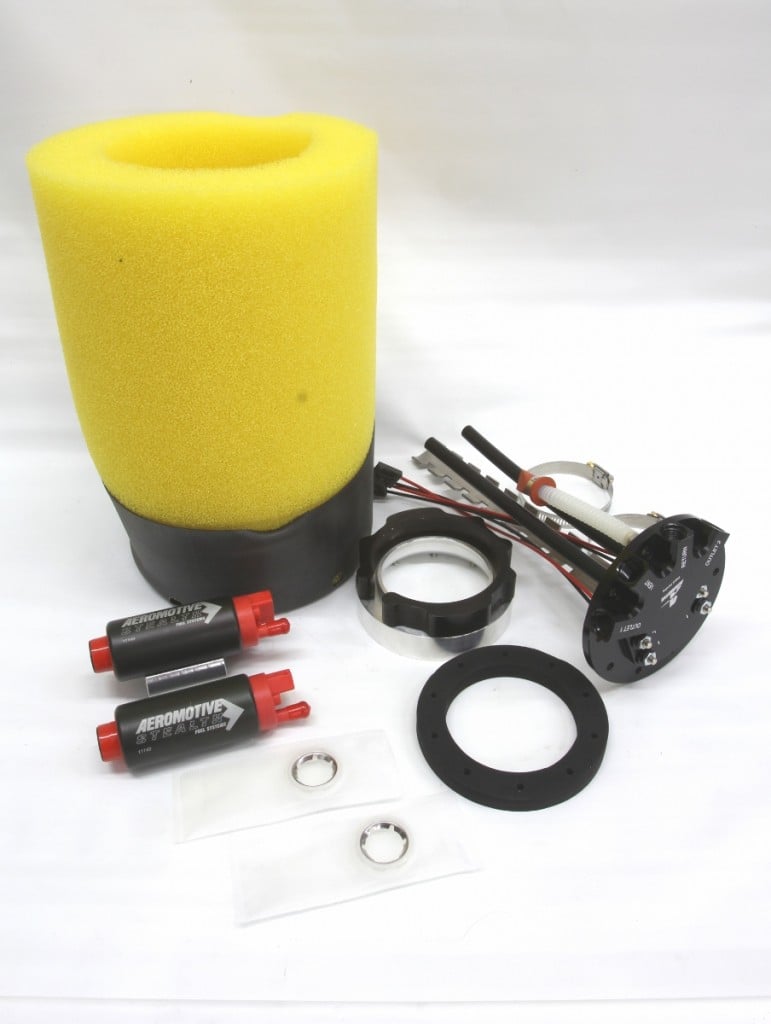
Aeromotive’s Phantom kit is the prototypical kit many of these other systems have emulated. The small black bucket serves as the fuel reservoir, while the yellow cell foam retains the fuel near the pump inlet. Aeromotive offers several size pumps, including this dual 340 lph combination. This dual 340 lph kit can supply a forced induction EFI engine up to 1,400 hp!
The simplest fuel delivery system ever devised was the Model T version that gravity-fed fuel from a tank sitting above the carburetor. Eventually, safety concerns moved the fuel tank to the rear of the car and engine-driven pumps were the norm. The earliest muscle car EFI conversions back in the 1980s merely placed an external high-pressure electric fuel pump alongside the tank with a line back to the tank for the return. This worked fine with a full tank of fuel. But, during acceleration with less than a half tank of gas, the fuel sloshed to the rear of the tank and uncovered the inlet. The pump sucked air, the fuel pressure plummeted, and the engine hesitated or flat-out died from fuel starvation. It was not a very good solution.
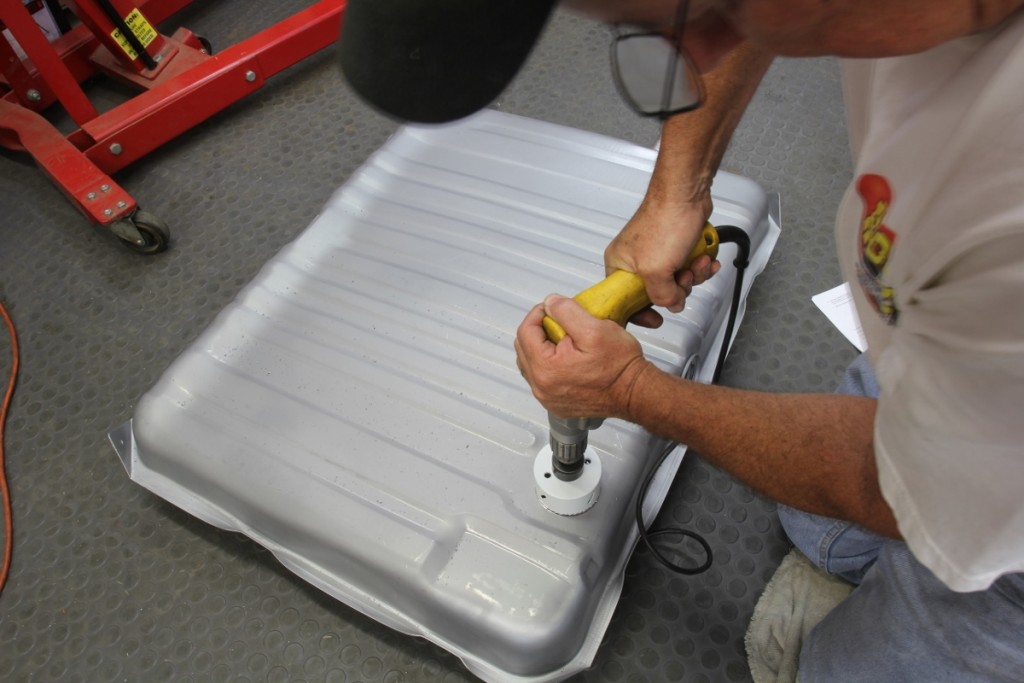
Most pump kits require drilling a large hole in your tank to locate the pump. This early El Camino tank offered a perfect location. If a flat area is not available, most sealing gaskets are designed to accommodate roughly ¼-inch ribbing. If the ribbing is deeper than this, Holley recommends using a Dow Corning fluorosilicone RTV (PN 730) to help seal. Be aware that a 3 oz. tube of this stuff costs $90. Gasoline will not break down this type of RTV, but it will easily dissolve normal silicone.
This never occurs with a carbureted system because the float bowl acts as a small reservoir. So, it should be obvious that any quality EFI fuel delivery system should involve an in-tank pump that immerses the pump inlet in fuel at all times. Another in-tank advantage is that with fuel surrounding the pump, it will run significantly cooler than any externally-mounted pump.
The OEs have done an outstanding job of improving upon fuel delivery, while the aftermarket is still evolving. All OE systems now operate as returnless systems using pulse-width modulation (PWM) control over the fuel pressure. It’s worth knowing how this works, as there are opportunities we’ll show you for retro-fitting this system into older cars.
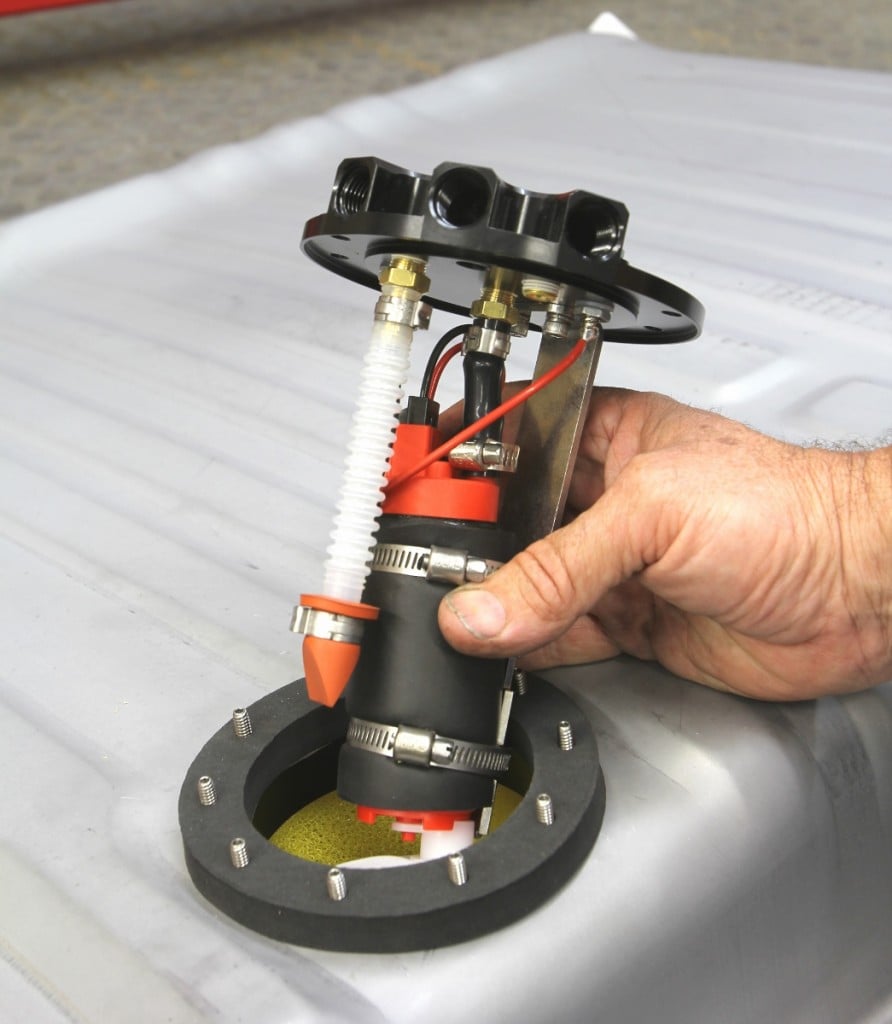
Converting a stock tank using the Aeromotive kit is not difficult. We completed the task on a new tank in less than four hours, and that included the time it required to drive to the hardware store to purchase the 3 ¼-inch hole saw.
Pulse width modulation is a truly elegant form of fuel pump motor control. In normal fuel pump operation, full power of 13.5 volts (or more) is applied, and the pump spins at its maximum speed and pressure. PWM control uses a microprocessor that applies short pulses of full electrical power to the pump motor. The best way to describe this is through the effect of duty cycle. With a 50-percent duty cycle, power is applied to the motor only 50 percent of the time. If you were to connect a voltmeter to the motor, the voltage readout would average the reading (so, half of 13.5 volts would be 6.75 volts), which is misleading. The reality is that a full 13.5 volts is applied, but only for half the time.
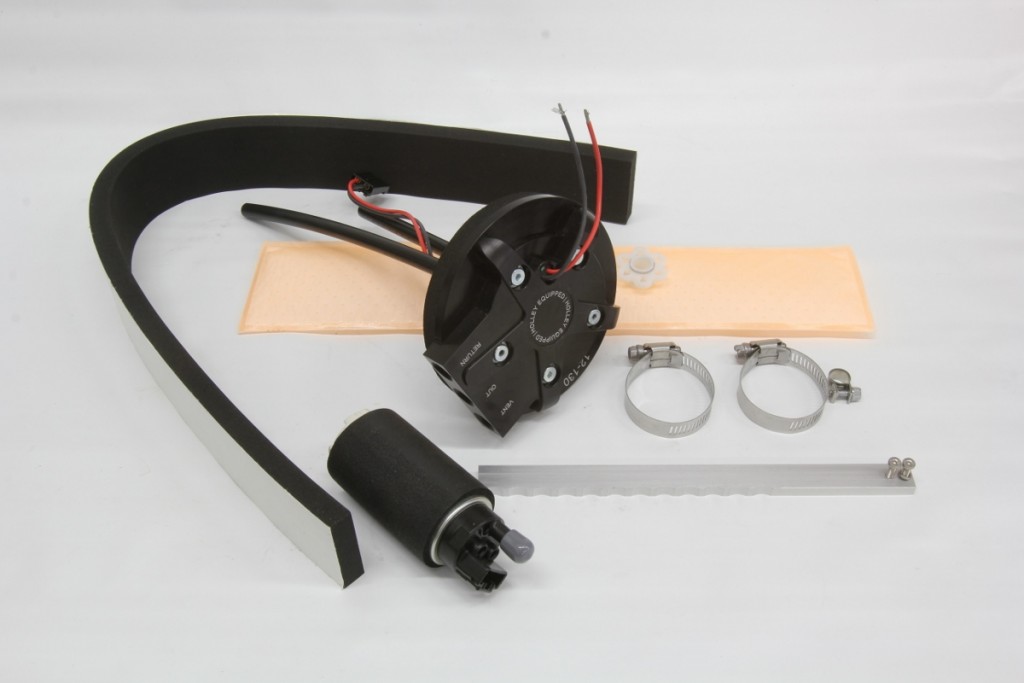
The Holley retro-fit fuel pump conversion includes the usual aluminum lid, but instead of a reservoir, uses its HydraMat material as the fuel pickup and inlet filter. As long as some portion of the mat is in contact with fuel, the rest of the mat closes so only fuel is pulled into the pump inlet. It’s pretty slick.
This allows the ECU to control fuel pressure by spinning the pump with just enough power to create the desired fuel pressure. During cruise operation, where only perhaps 10 percent of the pump’s potential fuel volume is required, the ECU will minimize the duty cycle to the pump to create sufficient pressure and volume to meet the demand.
Conversely, a typical return-style fuel system operates the pump at 100 percent all the time. The volume of fuel that isn’t needed is returned to the tank by the pressure regulator. The problem with a return system is fuel is constantly being pumped and returned, which pulls heat out of the pump and hot fuel rails with every cycle. Eventually, this tends to heat the fuel, which can cause vapor lock problems. This is one reason why the OEs chose returnless.
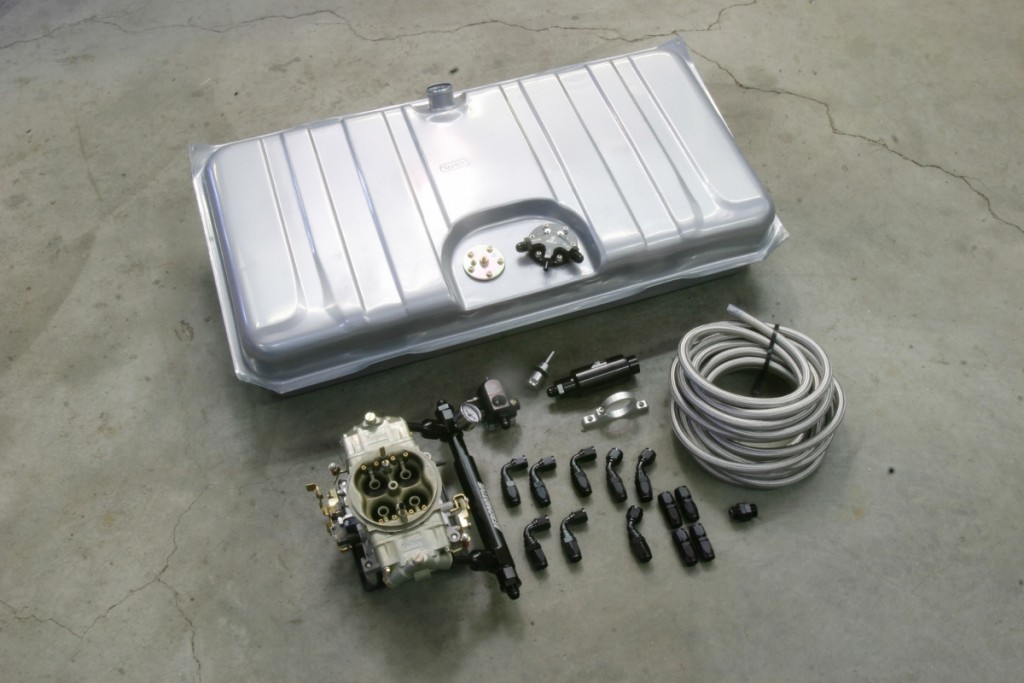
Aeromotive offers a few popular Stealth tank assemblies already converted to an in-tank pump with built-in sump that will feed a carbureted engine up to 1,000 hp. The Aeromotive catalog lists more than 30 different applications. This kit is for an early Camaro. There also is a tank with angled front corners to clear large tail pipes.
While there are multiple advantages to a returnless system, this should not be viewed as a condemnation of a return-style system. In fact, for a majority of normally aspirated street engines, the return-style has many positive aspects. Perhaps its biggest detraction would be the cost of the extra return line and fitting. It is certainly acceptable to employ a new feed line and use the car’s original fuel line as the return to save money.
One of the advantages of many of these conversion kits is a custom fuel tank is not required. The Aeromotive, Holley, FiTech, and FueLab kits employ a large aluminum top mount that supports the pump. Each kit offers a range of fuel tank depths they can work within, so it’s important to do your homework to ensure the kit will work with your intended fuel tank.
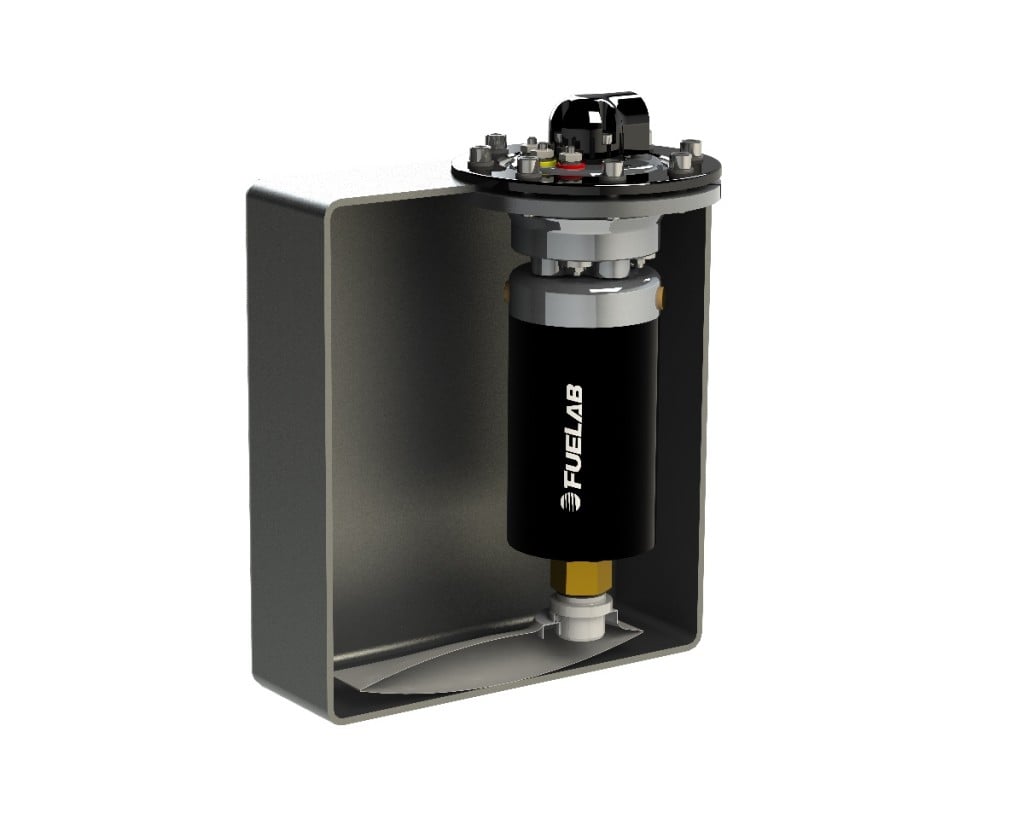
FueLab’s Prodigy in-tank pump kits offer a choice of two pumps that adapt to a stock tank using the Fabricator system. The formed reservoir retains the fuel to prevent pump starvation under fuel slosh conditions.
Of course, there are also several companies offering custom tanks with top fittings already in place for given pump conversions. Aeromotive, Rick’s Tanks, Tanks Inc., and others offer specific fuel tanks in galvanized steel, aluminum, and stainless. It’s also relatively easy to convert an existing fuel cell to an in-tank pump, so there are multiple opportunities.
The first of the pump-on-a-stick systems was Aeromotive’s Phantom, which now offers several optional in-tank pumps to a length of steel that suspends from the cover. A large hole is cut in the top of the tank to access the interior. The most critical part of the install is positioning the pump pickup as close to the tank floor as possible. The Phantom uses a black plastic reservoir underneath the pump, along with a section of fuel cell foam, to retain fuel around the inlet. Fuel is pulled in through small holes in the black reservoir. Aeromotive also offers selected tanks designed to accommodate the Phantom system.
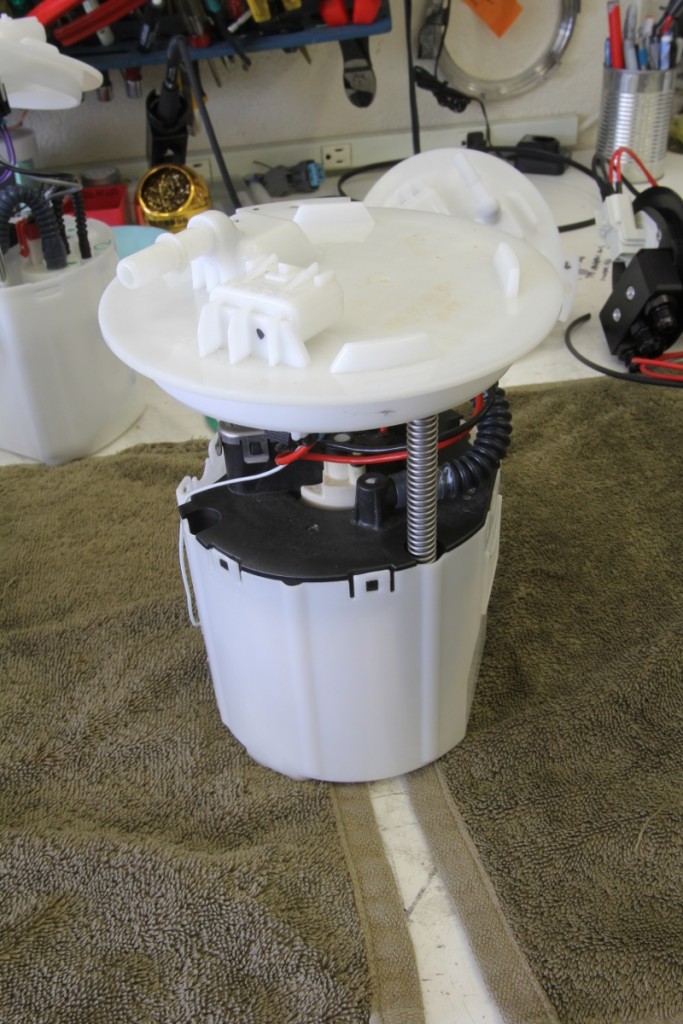
The VaporWorx system centers around a factory GM fuel pump module. Inside this round plastic cage is the pump and internal reservoir. It is spring loaded to be loaded against the bottom of the tank and designed to be returnless. Even with very low fuel level in the tank, the reservoir will always remain full.
The Holley Retro-Fit system is similarly configured, but instead of creating a reservoir around the pump, Holley employs its HydraMat material as a dedicated fuel pickup and 15-micron pre-filter. We’ve already covered how the HydraMat works in a previous Power & Performance News story, but as a quick explanation, the HydraMat uses a unique cell design that allows it to pick up even the smallest amount of fuel that comes in contact with the mat anywhere on its surface. If the HydraMat is carefully angled across the bottom of the tank, it would create the opportunity to pick up even very low fuel levels.
Tanks, Inc. also has created a similar pump-on-a-stick strategy, using a small reservoir that surrounds a selection of different pumps. The reservoir is simplistic, but the return line is also positioned to place fuel in the same vicinity. The company also sells dedicated EFI tanks that allow you to bolt the EFI pump reservoir system to the tank with no modifications.
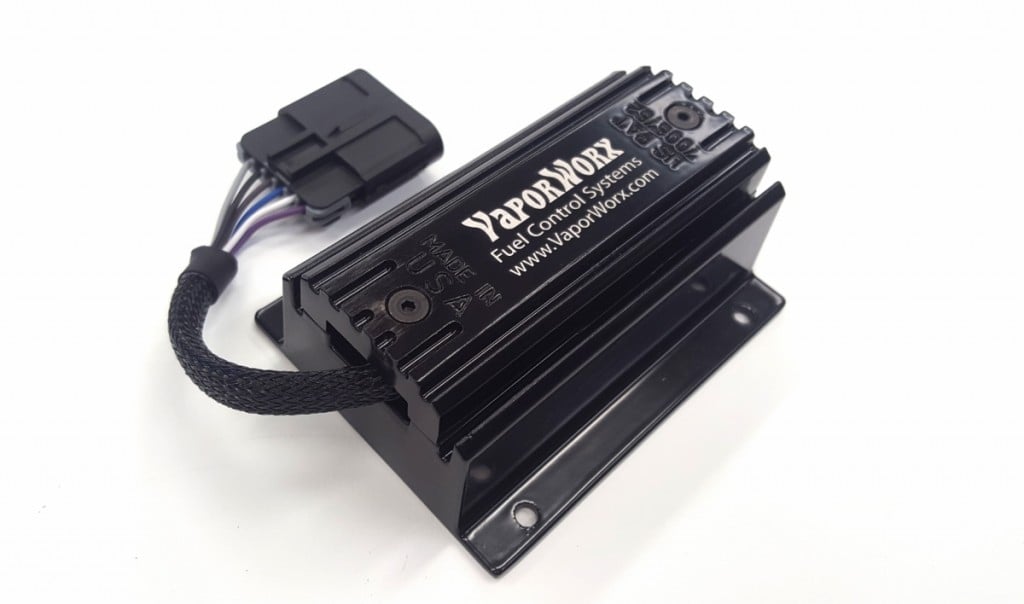
The VaporWorx system relies on a custom PWM controller and factory fuel pressure sensor to maintain the proper fuel pressure, so no return line is required.
FueLab is another company that offers a similar retro-fit package. FueLab has been in business for many years and created some interesting and unique products, such as its electronically-controlled fuel pressure regulator. For EFI systems, FueLab offers what is called its In-Tank Power Module consisting of a Prodigy fuel pump combined with a Fabricator series adapter that is a combination pump mount and reservoir.
FiTech has also introduced its own in-tank retro-fit kit called the Hy-Fuel system and has come on the market at a very affordable price. The kit uses a 340 lph pump and offers the option of a returnless configuration using a fuel pressure regulator mounted in the lid. Or, there is the option of building a full return-style system and bypassing this regulator by closing off the internal return channel. The large inlet filter also uses a similar technology to the Hydramat that allows it to pull fuel from anywhere the gasoline is in contact with the filter. The aluminum mounting flange can swivel once located in the tank, before you tighten down the clamps.
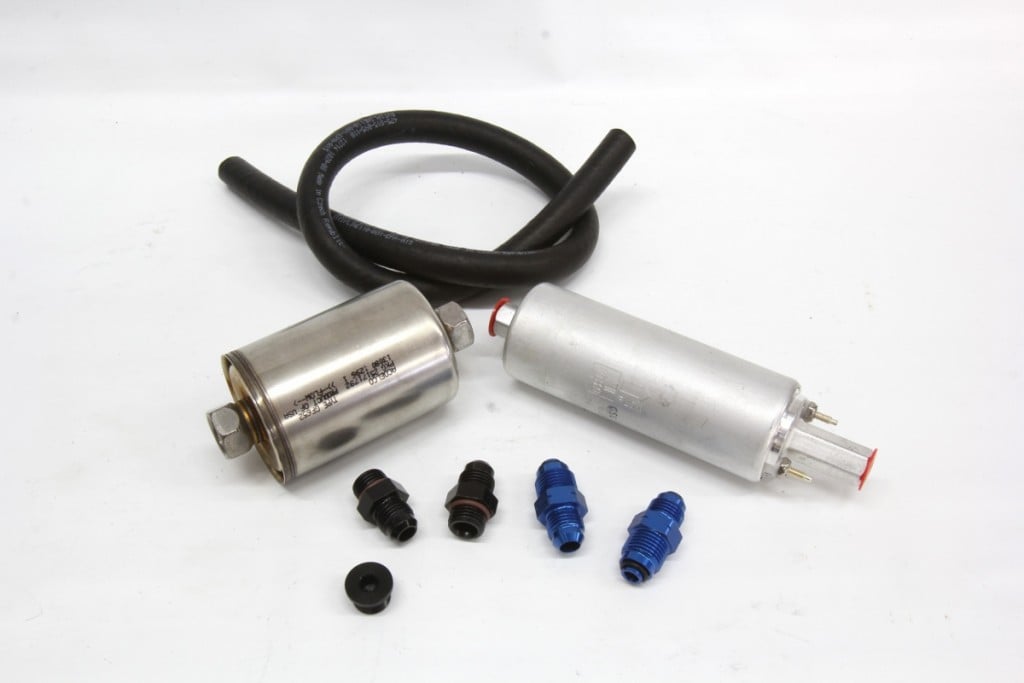
Most EFI companies offer kits like this FAST system using a Bosch external pump, bracket, and fittings. While inexpensive, this is not the best approach. If you choose to run an external pump, place it below the fuel level and as close to the inlet as possible. This could be combined with a Holley HydraMat for a quick EFI pump install, but this would still not be as good as an in-tank application.
VaporWorx took a more advanced approach to the question of retro-fitting an EFI fuel system. Rather than use an aftermarket pump, VaporWorx chose to champion the OE route by using GM factory fuel pump modules, such as those used in the fifth generation Camaros and Corvettes. These factory modules place a pump inside a dedicated reservoir using an internal jet pump that siphons fuel from the main pump to ensure full fuel level inside the module to feed the pump.
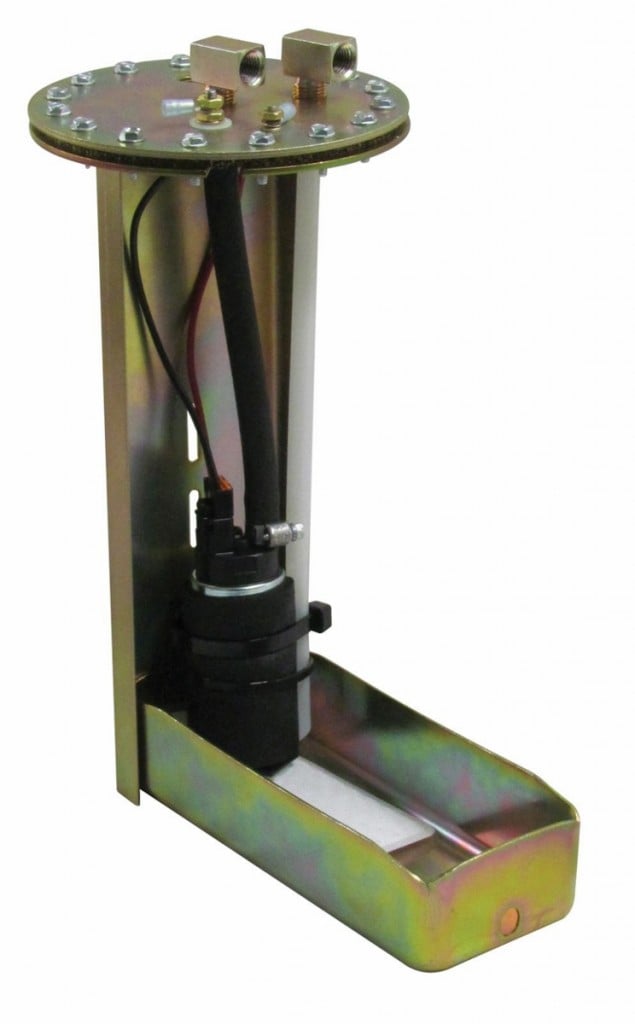
The Tanks, Inc. conversion system revolves around the classic arrangement with a small tray at the pump’s base for a reservoir.
VaporWorx doesn’t sell the pump, as they are universally available. What the company does offer is a factory-style sealing ring that can be welded to your existing tank that uses a factory seal. Or, you can purchase a tank from Rick’s Tanks that positions the factory sealing ring and module.
Because the VaporWorx system essentially retro-fits a factory-true returnless design, this demands a dedicated Vaporworx PWM controller. When combined with a factory GM fuel pressure sensor, the VaporWorx system maintains proper pressure and volume control. There are a few important aspects of this system that demand more attention than we can give them here. You can read a more detailed explanation of the entire VaporWorx system on its website.
It’s also worth noting the term returnless can be misleading. For example, the FiTech in-tank pump is configured with a regulator so fuel is returned internally back to the tank. This is not returnless design as an OE system. It’s important to understand a true returnless system must be monitored with a fuel pressure sensor and PWM controlled, while an internally returned system only needs a fuel pressure regulator. This may seem like a very fine point (which it is), but the distinction is important because the systems operate very differently.
FiTech is the latest company to create an in-tank retro-fit system. This kit will fit any tank depth between 6 and 14 inches. The system can be operated either as returnless or in return mode and features a 340 lph pump that will easily feed engines up to 800 hp. The 35-square-inch inlet filter also features the ability to pull fuel from any spot in contact with gasoline in the tank, so a reservoir is not essential.
There is far more to the total fuel delivery story than we can cover in this in-tank pump treatise. But, it is now possible to adequately feed a hungry, high-horsepower EFI engine with a system that is daily-driven reliable and even quiet. Perhaps best of all, these in-tank kits make it easy to feed all the horsepower you can dream up.
Conversion Factors
The following chart will give you the numbers to easily convert different pump rating systems into numbers you can use. The most useful is converting liters per hour (lph or l/h) into pounds per hour (lbs/hr). To achieve accurate flow numbers, input must be at the desired operating pressure and voltage. So, for an EFI system at 43 psi, let’s say we have a pump rated at 340 lph. Using the conversion chart: 340 x 1.66 = 564 lbs/hr. Assuming a naturally aspirated EFI engine operating with a brake specific fuel consumption of 0.50, the equation is 564/0.50 = 1,128 hp. Assuming some flow loss in the system, we can round this off to 1,000 hp. Supercharged EFI systems will lower this power number because of two factors. The first is higher fuel pressure is required to overcome the manifold boost pressure, and the second is the engine will demand a significant amount of fuel to create the power to drive the blower. That’s why pumps are rated differently between carbureted, EFI, and supercharged.
Liters /Hour
| Convert | Multiply By | Result |
| Liters | 0.264 | Gallons |
| Liters per Hour | 0.264 | Gallons per hour |
| Liters per Hour (gasoline) | 1.66 | Lbs/hr (gasoline) |
| Gallons | 6.2 | Pounds of fuel |
| Pounds of Fuel | 0.600 | Liters of fuel |
| Cc’s per minute | 0.016 | Gallons per hour |
Parts List
| Description | PN | Source | Price |
| Aeromotive Phantom 200 lph | 18689 | Summit Racing | $459.97 |
| Aeromotive Phantom 340 lph | 18688 | Summit Racing | $463.97 |
| Aeromotive Phantom 450 lph | 18310 | Summit Racing | $593.97 |
| Aeromotive Phantom Dual 340 | 18309 | Summit Racing | $676.84 |
| Holley, 255 lph, Return | 12-130 | Summit Racing | $439.95 |
| Holley, 255 lph, Returnless | 12-131 | Summit Racing | $489.95 |
| Holley, 450 lph, Return | 12-132 | Summit Racing | $539.95 |
| Holley, 450 lph, Returnless | 12-133 | Summit Racing | $589.95 |
| FiTech Hy-Fuel Retrofit pump kit | 40019 | FiTech | $349.00 |
| Tanks, Inc. 190 lph pump insert | PA-2 | Summit Racing | $235.97 |
| Tanks, Inc. 255 lph pump insert | PA-4 | Summit Racing | $235.97 |
| Tanks, Inc. 400 lph pump insert | PA-6 | Summit Racing | $295.97 |
| VaporWorx retro-fit controller, harness | PWZL13B-23IT | VaporWorx | $429.00 |
| ‘14 Camaro AC Delco fuel 1LE | M100081 | RockAuto | $183.79 |
| FueLab Prodigy in-tank pump, 800 hp | 90902 | Summit Racing | $449.82 |
| FueLab Prodigy pump, 1,000 hp | 91901 | Summit Racing | $477.36 |
| FueLab Fabricator install system | 20901 | Summit Racing | $95.47 |
Sources: Aeromotive, aeromotiveinc.com; FiTech Fuel Injection, Fitechefi.com; FueLab, FueLab.com; Holley Performance Products, holley.com; Rick’s Tanks, Rickstanks.com; Tank’s, Inc.,Tanksinc.com; VaporWorxs, Vaporworxs.com




